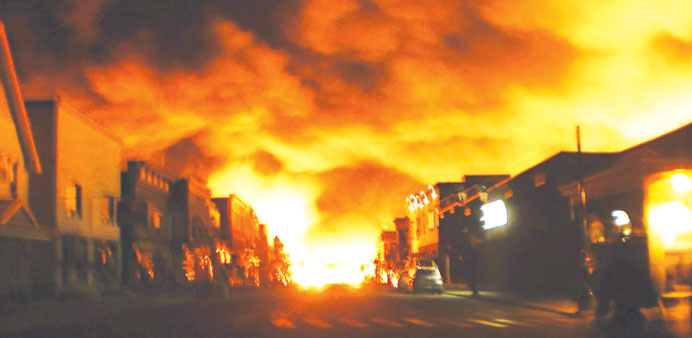|
Gilles Orichefski says he always knew that the oil-laden trains chugging along the rail track behind his house were a disaster waiting to happen. |
From the porch of their hillside house on Laval Street in this picturesque town of 6,000 near the border with the US state of Maine, Orichefski and his wife Jacqueline Roy can see what remains of Lac-Megantic’s downtown after a runaway tanker-train exploded and snuffed out the lives of 47 people on July 6.
The fiery derailment of 72 tanker cars filled with highly flammable North Dakota crude has put under intense public scrutiny the oil industry’s growing reliance on rail transportation.
“The rail company started with five or six tanker cars and before we knew it, they were running entire trains with dozens of cars filled with oil,” said Orichefski, 79.
Michael Bourque, president and chief executive of the Railway Association of Canada, said shipments of crude oil by rail have risen considerably over the last five years.
“In 2009, Class I railways moved a minuscule 500 carloads of crude,” Bourque wrote in a recent online editorial. “Fast forward to this year and current estimates are in the range of 130,000 - 140,000 carloads.”
Railways in the US have also seen a similar increase in oil transportation driven by the dramatic growth in shale oil production and limited pipeline capacity.
Statistics released by the Association of American Railroads show that in 2012 US railroads moved 234,000 carloads of oil, up from 97,000 in 2008. With more than 97,000 rail carloads of crude oil transported just in the first quarter of this year, 2013 is expected to be another record year.
But as recovery crews in Lac-Megantic, about 250km east of Montreal, continue their gruesome task of digging out charred bodies of victims of the derailment, a growing chorus of voices calls on governments in Canada and the US to introduce tougher regulation of transportation of oil and other dangerous goods.
Investigators with Canada’s Transportation Safety Board working on identifying the cause of the railway disaster in Lac-Megantic have come out with a series of urgent recommendations to Transport Canada, the federal agency overseeing railways.
They include establishing clear guidelines on the number of brakes to be set on trains carrying dangerous materials and forbidding railway companies to leave these trains unattended.
Fearing a backlash, the rail transportation industry has launched a public relation campaign to reassure jittery residents living next to railroads that rail transportation remains one of the safest ways of transporting oil.
“An astounding 99.9977% of all rail dangerous goods shipments reach their destination without a release caused by train accident,” Bourque wrote in his editorial.
But those assurances have a hollow ring to Lac-Megantic residents.
Watching emergency crews work in the distance, Roy said she never wants to see another oil-tanker train go through her hometown.
“Some of my best childhood memories are connected with the railroad, taking train trips to Sherbrooke and Montreal with my family,” said Roy, 67. “But now I can’t bear the thought of another train going through. We won’t stand for that. We’ll lie down on the tracks to stop it.” - DPA



